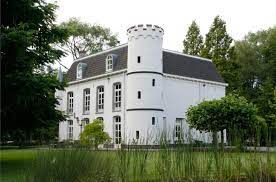Nature reserve De Mortelen and Estate Heerenbeek
Contact
Lopensestraat 1
Oirschot Plan your route to Nature reserve De Mortelen and Estate Heerenbeek

Walking through the Brabant countryside, as it used to be, is possible in the beautiful nature reserve De Mortelen. Starting points for your walk are the charming outdoor locations Hoeve 1827 and De Vrolijke Jager, both located on the Oude Grintweg.
The small-scale nature reserve De Mortelen includes forests, tree-lined avenues, rugged meadows, hedgerows, and streams. Landgoed Heerenbeek with its 'castle' and various long farmhouses also belongs to the area. The name 'mortelen' means: on soft, tender ground. The Mortelen area is part of the Groene Woud, a chain of large nature reserves in Central Brabant.
This small-scale natural landscape is of great …
Walking through the Brabant countryside, as it used to be, is possible in the beautiful nature reserve De Mortelen. Starting points for your walk are the charming outdoor locations Hoeve 1827 and De Vrolijke Jager, both located on the Oude Grintweg.
The small-scale nature reserve De Mortelen includes forests, tree-lined avenues, rugged meadows, hedgerows, and streams. Landgoed Heerenbeek with its 'castle' and various long farmhouses also belongs to the area. The name 'mortelen' means: on soft, tender ground. The Mortelen area is part of the Groene Woud, a chain of large nature reserves in Central Brabant.
This small-scale natural landscape is of great value, as much of this has been lost in the rest of North Brabant due to land consolidation. Roads and plot boundaries correspond to natural landscape elements such as small height differences. Cultivation was done individually in the form of camps: isolated fields amid wild ground, and this also included the existing sand hills (donken). The younger heath clearings in the north of the area are more extensive and have straight plots. Such a landscape is common in North Brabant. An example is the Kinderbos located in the northwest of the area. These heath reforestations aimed at soil improvement; much of it was cleared again in the second half of the 19th century to be converted into agricultural land.
Wood anemones are a typical vegetation for De Mortelen. The many moist groves in the cultural landscape are very old and served as coppice wood provisions. In the undergrowth of these, in the verges, and along watercourses, various plant species that bloom profusely in spring can be found, such as the mass-occurring wood anemone and cowslip. Other species include: fragrant agrimony, yellow archangel, golden buttercup, great woodruff, barren strawberry, Solomon's seal, and lily-of-the-valley. In shaded, wet areas, special ferns like the double-leafed fern grow; along paths, the inconspicuous hairy woodrush and the semi-parasite yellow rattle. In hidden places, rarities such as oneberry and bird's-nest orchid grow. Some groves are laid out on corduroy roads. The former meadows in the west of the area were once very wet, but nowadays, they are drier and more nutrient-rich.
Heerenbeek is the name of an estate located in the northern part of the municipality of Oirschot. It is part of the De Mortelen en Scheeken area of the Brabants Landschap Foundation. In 1303, Duke Jan II of Brabant gives a piece of land to the Vering of the Park Abbey in Leuven, and over the years, he adds more to it. Soon, a farmhouse is built, and the lands are brought into cultivation. In the 15th century, the entire estate is leased by the abbey. In 1628, the present Flemish barn behind the mansion is built by tenant Peter Maertens van Collenbergh. This barn is the oldest building on the estate; it is currently a national monument.
The current mansion dates from 1864 and has had various occupants, of which only one noble family, the Van Coehoorn family. Along the Oude Grintweg is the family cemetery of De Girard de Mielet van Coehoorn. In 1994, the last member - Aimery Menno Jan de Girard de Mielet van Coehoorn - was buried in this family grave.
The mansion is a municipal monument with white plastered walls and hanging towers, giving it the appearance of a small castle. In 1998, a fire broke out here, completely destroying the interior of the house. The house was fully restored. Today, it is privately owned and inhabited. From here, a driveway leads to the Oude Grintweg. The mansion provides a typical image of country houses with castle-like additions from the original construction period.
The estate is freely accessible throughout the year and has many beautiful hiking trails. The garden and buildings are not open to the public.


